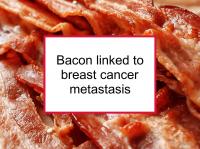While red meat consumption has been linked to increased breast cancer risk in population and animal studies, the risk is even higher for processed meats such as ham, sausages and bacon. The heightened risk appears to derive in part from the sodium nitrite and related compounds that normally are added to processed meats to preserve them.
Sodium nitrite has been shown to react with chemicals in the stomach to produce nitrosamines, which are known to be cancer-promoting. In addition to their nitrite content, the carcinogenic potential of processed meats appears to be related to the effects of frying or broiling, which have been shown to produce mutagenic compounds such as heterocyclic amines (HCAs) and polycyclic aromatic hydrocarbons (PAHs). One study reported that fried bacon had a higher level of HCAs than fried pork, fried beef and fried chicken. Also, high intake of animal fats has been linked in several studies to increased breast density, a risk factor for breast cancer and recurrence.
High intake of saturated fat from processed meats has also been found to be associated with increased risk of breast cancer, in part because of their high cholesterol content. High cholesterol has been shown to promote metastasis in an animal model of breast cancer. Now a new study has reported that bacon drippings have especially high potential to induce metastasis since frying bacon results in a particularly harmful cholesterol metabolite.
Lard and breast cancer
Lard (rendered pork fat) is undergoing a resurgence in American cooking, as various celebrity chefs have highlighted its usefulness in frying and baking. Other commentators are attempting to debunk lard's reputation as an unhealthy, high saturated fat ingredient. However, while there may be room for debate regarding lard's influence on cardiovascular health, available studies indicate that lard is a risk factor for breast cancer. Epidemiological studies in regions and during times when lard was a more common cooking ingredient have reported relatively strong associations between lard consumption and breast cancer risk. For example, Chinese, Brazilian and Tanzanian studies have reported links between use of lard and breast cancer. In addition, a diet high in lard has been shown to increase mammary tumor incidence and size in a mouse model of triple negative (ER-/PR-/HER2-) breast cancer. Therefore, it makes sense that rendered bacon fat should also be avoided as a cooking ingredient.
Latest research finds bacon fat is particularly harmful
The study referenced above was designed to investigate the metastatic effects of cholesterol from bacon drippings. High cholesterol levels have been found to be associated with poor breast cancer prognosis, whereas statins, which lower cholesterol, appear to be protective. The authors showed previously that a high cholesterol diet promoted tumor growth and metastasis. The authors also found that the metastatic effects of cholesterol were primarily mediated by its metabolite, 27-hydroxycholesterol (27HC). 27HC required neutrophils and gamma delta T cells for its metastatic effects. In the current study, the authors tested the hypothesis that the consumption of high cholesterol foods, and oxidized cholesterol products in particular, promote breast cancer metastasis.
To conduct the study, the authors used a mouse model of breast cancer, in which similar groups of mice were placed on various diets for four weeks, after which they received intravenous infusions of Met1 mouse mammary tumor cells. After an additional five weeks, imaging was used to assess metastasis.
Bacon is normally prepared by frying in its own fat. The authors used a controlled pan-frying procedure to produce bacon oil, which was collected and processed into food pellets as needed. The diets consisted of (1) a high bacon fat diet (5% lipid from bacon frying fat, 5% lipid from soybean oil); (2) a lard diet (5% fat from rendered pork lard, 5% lipid from soybean oil); and (3) a no cholesterol diet (10% soybean oil). To test the relative contribution of cholesterol to observed changes in metastatic colonization and outgrown, the authors also tested the effects of treatment with ezetimibe, an anti-cholesterol drug. The various mouse groups had comparable weight gain.
Compared to the no cholesterol diet, there was a significant increase in the number and size of metastases in the lard diet group. However, the bacon oil diet group had even greater metastatic burden than the lard group. This increase lessened when mice were treated with ezetimibe. The authors are conducting additional studies to assess circulating cholesterol and oxysterol concentrations, and to evaluate changes in the metastatic microenvironment in the mice according to their respective diets. The authors conclude that while, as previously determined, cholesterol consumption increases metastatic progression, its preparation prior to consumption can also have significant impact.
Please see on our bacon page for more information.
